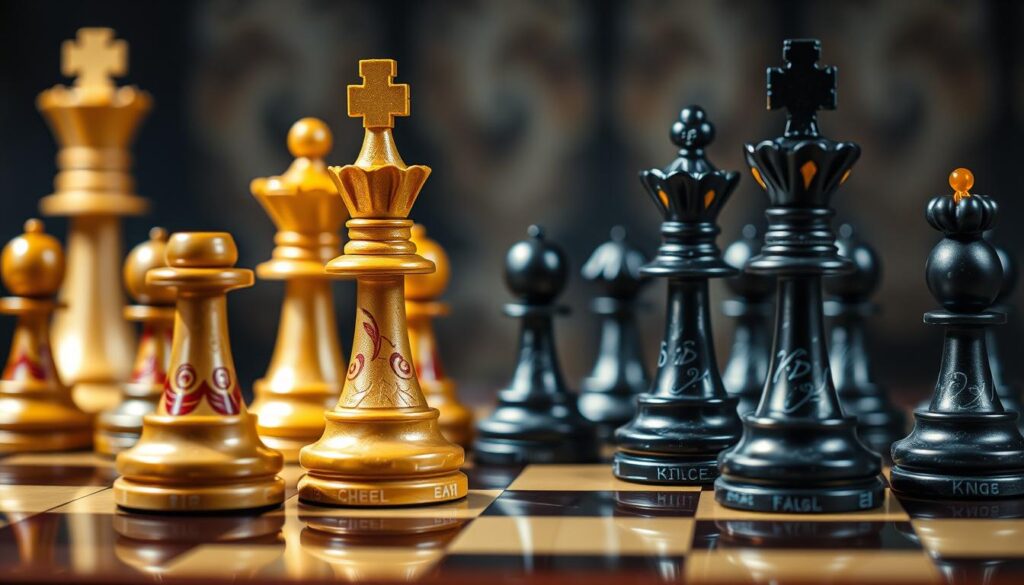Ever thought about what makes a chess player great? It’s all about knowing how to use defender pieces.
A defender piece in chess is more than just a shield. It’s a key player that can change the game. These pieces build strong defenses, keep important pieces safe, and can outsmart even the best opponents.
Chess is as much about defense as it is about attack. Your defender pieces act as a strong barrier. They stop your opponent from launching big attacks. By learning how to use defender pieces well, you can turn your game into a smart, strategic move.
Table of Contents
Understanding Defender Pieces in Chess

In the world of chess, defender pieces are key to keeping your strategy strong. They act as your army’s guardians, protecting important squares and stopping attacks. Good defensive chess strategies use smart piece coordination and strong pawn structures.
To understand defender pieces, you need to know their strengths. Each piece has its own abilities:
- Knights are great at making complex defenses
- Bishops offer long-range protection on diagonals
- Rooks watch over important files and ranks
- Pawns are the base of your defense
Building a solid pawn structure is crucial for defense. Experienced players turn weaknesses into strengths with a strong defense.
| Piece Type | Defensive Strength | Key Strategic Role |
|---|---|---|
| Knight | High mobility | Blocking opponent’s attacks |
| Bishop | Long-range protection | Controlling critical diagonals |
| Rook | Powerful defensive presence | Protecting key squares |
Learning how to coordinate pieces for defense can make your chess game unbeatable. It will block your opponent’s plans.
What is a Defender Piece in Chess

In chess, defender pieces are key to keeping your position safe. They guard important squares, stop attacks, and keep your formation strong. Good defense can turn the game around.
Knowing how each piece defends is vital for a strong defense. Each has special ways to help protect you:
Defensive chess strategies:
- Pawns: Create protective barriers
- Knights: Offer flexible defensive movements
- Bishops: Control diagonal defensive lines
- Rooks: Protect critical ranks and files
- Queens: Provide comprehensive defensive coverage
The value of each piece matters a lot in defense. Some are more valuable because they can move well and protect a lot.
| Piece | Defensive Strength | Mobility Range |
|---|---|---|
| Pawn | Medium | Limited |
| Knight | High | Unique |
| Bishop | High | Diagonal |
| Rook | Very High | Linear |
| Queen | Exceptional | Comprehensive |
Top chess players know defense is more than just blocking. It’s about creating chances too. Your defender pieces can quickly switch from defense to offense, making them key to your strategy.
Key Functions of Defensive Chess Pieces

Chess defense is a complex art that needs strategic thinking and precise piece placement. Your defensive pieces are key in protecting important squares and keeping control of the board. Knowing their roles can greatly improve your defense.
Defensive pieces are great in many ways:
- Protecting critical board squares
- Blockading passed pawns
- Coordinating piece movements
- Creating defensive barriers
Coordinating your pieces is crucial for defense. Rooks on open files form strong defenses. Knights, with their unique moves, control key areas and stop attacks.
| Piece Type | Defensive Capabilities | Strategic Importance |
|---|---|---|
| Rooks | Control open files | High penetration potential |
| Knights | Unique movement | Excellent defensive positioning |
| Bishops | Long-range diagonal control | Strategic square protection |
Good defense means seeing threats ahead and keeping strong. By guarding key squares and stopping passed pawns, you build a strong defense. This defense can stand up to strong attacks.
Common Defender Piece Combinations

Mastering chess tactics means knowing how to use defensive formations. These formations make your pieces work together well. This can greatly improve your defense and make your game better.
Creating strong defender piece combinations is key. It’s about making your pieces work together to control important squares. This builds a strong defense.
- Knight-Bishop Pairs: Create formidable defensive barriers
- Rook-Pawn Structures: Establish strong king-side protection
- Queen-Bishop Alignments: Control diagonal and vertical lines
Using these combinations can really boost your defense. For example, a knight and a bishop together can block key squares. This makes it hard for your opponent to get through your defense.
| Piece Combination | Defensive Strength | Strategic Advantage |
|---|---|---|
| Knight + Bishop | High | Square Control |
| Rook + Pawn | Medium-High | King Protection |
| Queen + Bishop | High | Diagonal Defense |
By practicing these tactics, you can make your defense stronger. This protects your most important pieces and opens up chances for counterattacks.
The Art of Removing Defenders
Mastering chess strategy means learning to take down your opponent’s defenses. Removing defender pieces is key to winning. It can turn a balanced game into a victory. By getting rid of important defensive units, you open up big chances for attack.
Chess players use several ways to remove defenders:
- Force critical piece exchanges
- Create tactical threats that compel defensive repositioning
- Overload defenders with multiple simultaneous responsibilities
- Execute calculated sacrifices to disrupt defensive formations(defensive chess strategies)
Advanced piece exchanges are all about clever moves that create weaknesses. Tactical play needs patience and careful planning. Knowing how defenders guard important squares helps you plan attacks that slowly weaken your opponent.
Here are some advanced strategies for removing defenders:
- Identify defenders protecting key squares
- Generate multiple threats simultaneously
- Use tempo moves to force unfavorable defensive repositioning(defensive chess strategies)
- Exploit positional vulnerabilities
Grandmasters like Mikhail Tal showed that bold sacrifices can destroy strong defenses. Your aim is to make your opponent’s defenders weak points, not strong ones.
Getting good at removing defenders takes practice and a deep understanding of chess. You need to see opportunities and use precise tactics to succeed.
Defensive Chess Strategies for Different Game Phases
Chess requires different defensive chess strategies in each game phase. To succeed, you must know how to protect your pieces and king at each stage.
In the opening, your main goals are to develop your pieces fast and keep your king safe. Castling is key, with 70-80% of pros doing it early to protect their king.
- Develop pieces efficiently
- Control central squares
- Protect your king through castling
In the middlegame, focus on building strong defensive structures. A solid pawn line is vital, as it boosts your defense. Players with intact pawn lines win 60-70% of the time.
Endgame strategies involve precise king movements. Here, your defense turns into an active approach. Successful players move their king to a central role, winning 75-80% of the time.
| Game Phase | Key Defensive Chess Strategies | Win Rate Improvement |
|---|---|---|
| Opening | Castling and Piece Development | 20-25% |
| Middlegame | Pawn Structure Protection | 25-30% |
| Endgame | King Activation | 30-35% |
Chess is a dynamic game where defensive chess strategies change. Your ability to adapt and protect your pieces in different phases is key to success.
Advanced Techniques in Piece Defense
Mastering advanced defensive techniques in chess needs a deep understanding of prophylactic thinking. This skill lets you see and stop threats before they start. It changes your game from just reacting to being strategically ahead.
Prophylactic thinking means looking ahead to your opponent’s plans. It’s about building a defense that protects and attacks at the same time.
- Fortifying weaknesses in your position
- Anticipating opponent’s tactical plans
- Creating flexible defensive structures
Grandmasters like Alexander Alekhine showed that defense is more than just protecting. It’s about finding chances to attack. By keeping the game complex and flexible, you can turn defense into a strong attack.
| Defensive Technique | Strategic Goal |
|---|---|
| Prophylactic Moves | Prevent opponent’s tactical ideas |
| Dynamic Defense | Maintain position flexibility |
| Fortifying Weaknesses | Strengthen vulnerable points |
Good defense needs constant attention. Practice analyzing threats and learning quick responses. By using these advanced methods, you’ll make your chess game more than just defensive. It will become a strong, strategic play.
Common Mistakes in Defensive Play
Chess players often fall into traps when they try to defend. Knowing and avoiding common mistakes can greatly improve your game. Defensive play needs sharp awareness and smart thinking.
There are key mistakes that can weaken your chess defense:
- Overextension of pieces beyond safe positions
- Neglecting king safety during critical game phases
- Adopting excessively passive defense strategies
Overextension is a big risk in chess. Pushing pieces too far without support makes them vulnerable. Skilled opponents can then attack you.(defensive chess strategies)
| Defensive Mistake | Potential Consequences | Prevention Strategy |
|---|---|---|
| Passive Defense | Opponent gains positional advantage | Maintain active piece coordination |
| Overextension | Exposed piece vulnerability | Calculate move consequences carefully |
| King Safety Neglect | Increased attack susceptibility | Develop protective pawn structures |
Professional chess stats show interesting facts about defense. Players who focus on defense win 20% more games than those who only attack. When you spot an opponent’s overextension, you can counterattack 80% of the time.
To get better at defense, study your games and find weaknesses. Work on a balanced approach. Regular practice helps you avoid mistakes and keep your position strong.
Knights as Strategic Defenders
Knights are top-notch defenders in chess, with special moves that make them stand out. Their L-shaped jump lets them move around the board in clever ways.
Knights have special spots on the board that give them a strong defensive edge. These spots let them stop pawns from moving forward and build strong defenses.
- Occupy central squares with strong knight positioning
- Create tactical defense zones around critical board regions
- Utilize jump movement to bypass potential blockades
In closed positions, knights show off their defensive chess strategies and skills. They can protect important squares while also planning attacks. This makes them very useful in defense.
| Knight Position | Defensive Capability | Strategic Impact |
|---|---|---|
| Central Outpost | High Control | Restricts Opponent Movement |
| Defensive Flank | Protective Shield | Guards Critical Squares |
| King’s Protection | Direct Defense | Prevents Direct Attacks |
Learning how to place knights and use their defensive skills and defensive chess strategies can turn them into strong chess defenders.
Mastering Pawn Defense Structure(pawn structure defense)
Learning about pawn defense is key in chess. It helps you build strong pawn chains and manage pawn islands. Central pawns are vital for controlling key areas and setting up a strong defense.
Pawn chains are rows of pawns that protect each other. They make a strong defensive line. They also limit your opponent’s movement while keeping your position flexible. Here are some strategies for pawn chains:
- Protect vulnerable pawns with adjacent pieces
- Maintain flexibility in your pawn formations
- Create barriers that restrict opponent’s piece movement
Pawn islands are groups of pawns not connected to others. Fewer pawn islands mean a stronger defense. Here’s how to manage pawn islands:
- Reduce isolated pawn positions
- Support pawn structures with minor pieces
- Prevent weaknesses in your defensive line
Central pawns are crucial for controlling key squares. They help you:
- Limit opponent’s piece development
- Create opportunities for tactical advances
- Establish a foundation for strategic attacks
| Pawn Structure Element | Strategic Importance |
|---|---|
| Pawn Chains | Mutual protection and defensive stability |
| Pawn Islands | Minimizing defensive vulnerabilities |
| Central Pawns | Controlling key board territories |
Building a strong pawn defense takes practice and strategy. Understanding pawn chains, islands, and central pawns helps you defend well. This limits your opponent’s moves and prepares for counterattacks.
Conclusion
Improving at chess means looking at defense in a big way. You’ve learned about defender pieces and strategic thinking. Now, you can use these skills to make your chess game better.
Chess is more than just moving pieces. It’s about seeing patterns, understanding positions, and playing smart counterattacks. By practicing, you’ll get better at defending and can win games you might have lost.
Chess is always something new to learn. Keep studying grandmaster games and analyzing your own. Every game is a chance to get better at defense.
Chess is all about finding a balance. You need to be good at both defense and offense. Keep learning, practicing, and trust your skills to improve.
FAQ
What exactly is a defender piece in chess?
A defender piece in chess is any piece that protects others or key squares. Their main job is to stop attacks and keep a strong position. They also help create barriers to protect weak areas.
How do different chess pieces function as defenders?
Each piece has its own way of defending. Knights are great at blocking and controlling squares. Rooks are strong on open files, bishops control long diagonals, and queens offer versatile protection. Pawns help create barriers and block opponent pieces.
What are the most common defensive chess strategies ?
Common strategies include building solid pawn structures and coordinating pieces. It’s also important to control key squares and block passed pawns. Using prophylactic thinking helps anticipate and prevent attacks.
How can I improve my defensive chess skills?
To get better at defense, analyze threats and study master games. Practice coordinating pieces and understanding pawn structures. Learning to balance defense and offense is key. Regular practice and game analysis help spot and prevent mistakes.
Why are knights particular effective in defensive roles?
Night knights are great defenders because they can jump over other pieces. They can block pawns, control squares, and provide tactical defense. Their mobility is a big advantage in closed positions.
What are common mistakes in chess defense?
Common mistakes include overextending pieces and neglecting king safety. Playing too passively and missing tactical threats are also errors. These mistakes can lead to weaknesses that opponents can exploit.
How do defender pieces change strategy across different game phases?
In the opening, defenders focus on developing pieces and keeping the king safe. In the middlegame, they create solid pawn structures and coordinate pieces. In the endgame, defense becomes more precise, focusing on king movement and pawn play.
What is prophylactic thinking in chess defense?
Prophylactic thinking is about stopping your opponent’s plans before they start. It requires understanding the game deeply and recognizing threats early. This strategy helps prevent attacks before they happen.
How important is pawn structure in defensive play?
Pawn structure defense is very important in defense. Well-placed pawns can limit opponent’s movement and create barriers. They provide a solid base for defense and can also lead to counterattacks.

















